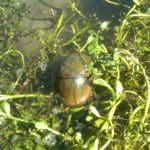[one_fourth]


[/one_fourth]
[three_fourth_last]
Undergraduate Research Project 2014
Title: An Apple Snail a Day Keeps the Plants Away: Effects of an Invasive Snail on Aquatic Plants and Ecosystems
Objective: This study focuses on the effects of low, medium, and high densities of non-native snail, Pomacea insularum, on the pH, dissolved oxygen, nutrient concentrations, and turbidity of aquatic ecosystems as well as changes in plant community composition that may lead to the domination of the invasive plant Hydrilla verticillata.
Abstract: The island apple snail, Pomacea insularum, is an invasive species similar to the channeled apple snail, Pomacea canaliculata, which ravaged the rice paddies of southeast Asia and is considered one of the world’s top 100 most devastating invasive species. P. insularum was introduced to Florida in the 1970s and poses a threat due to its high reproductive capacity and feeding preferences for native aquatic plants. Few studies have investigated density effects of P. insularum and none have explored the impact of its feeding habits on the invasive plant Hydrilla verticillata. This experiment will investigate effects of various population densities of P. insularum on different physical characteristics of aquatic ecosystems, and the potential of invasive snails to increase the dominance of invasive plants. Results will be obtained by testing four densities of snails – low, medium, and high, as well as control – in experimental tanks to determine the snails’ effect on pH, nutrient concentration, dissolved oxygen, and turbidity. The composition of the plant community will also be observed by recording percent cover of each species throughout the experiment to examine changes caused by the snails. It is expected that higher densities of snails will cause a change to an alternative stable state characterized by high algae concentration and the consumption of all plants. Preferential feeding by P. insularum is expected to increase the cover of H. verticillata. This outcome would pose a threat to aquatic ecosystem health due to the loss of ecosystem services such as purified water.
[/three_fourth_last]